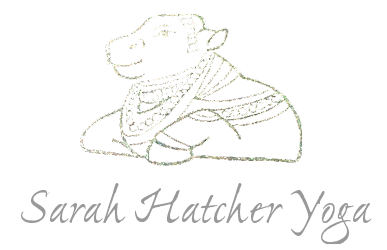Swinging in the Trees
Ashtanga Yoga Edinburgh has the most incredible windows that look out into a glorious park, The Meadows. This morning while in my practice, I came up from Prasarita Padotonosana A, and when I looked straight ahead, my view was of giant healthy trees. I became so attached in the beauty of these trees for a moment, I became heavy and earthy, just like them. It was clear I was envious of their ability to be so voluptuous and I wanted to be one. [This may happen Patanjali says when we attach ourselves to what we meditate upon - see what happens if we do not stay attached by clicking here - Yoga Sutra 3.38.)
They each had huge bases that appeared to make the surrounding environment around them - including me gazing at them - so small. Their barky bodies - hardy and furry with protection - reminded me that to go upwards and grow, there must be a strong downward force - imagine the roots on those babies!
With all the "supta up!" such as lifting and swinging and jumping back and forward in the ashtanga yoga practice, it is important to remember to go down into the earth as well - especially while practicing the standing asanas.
For the arm balances of the Advanced Series as well as throughout the primary and intermediate - there is a huge emphasis on the ability to lift up off of the ground. Once you have figured out how to go up, it is just as important to figure out how to land and how to go back down. Often I feel myself going upwards and not enough downwards or even outwards - the opposite of the action I am working so hard to do. When this happens there is no ease and a lot of effort: I feel myself over working, trying too hard and well, just practicing without any results.
An old friend once told me, "If you are going to be stupid, you better be tough."
The pairing of opposites is latent within a yoga practice and must be present in one's daily efforts - in order to join the physical practice with the mental one. Patanjali uses the word "dvandvah" (Sutra 11.48) which is translated as "duality" to describe these opposites.
There are three yoga sutras about asana - and this is the last of the three suggesting that when the yogi has perfected asana (effortless effort and benevolent steadiness) then he or she is "undisturbed by dualities". Iyengar, "Light on the Yoga Sutras of Patanjali". The "dualities" can be anything like hot or cold; joy or sorrow; pain or pleasure...they can also be upwards and downwards, forwards and backwards, and directional - think of the inner vayus that fill the inner body like wind in all directions.
An image like a billowing tree in a picturesque Meadow helped me realize that for every arm balance that needs a ton of effort to move upwards to hold, there needs to be a downward force like no other to vacuum (pull up) the energy being pushed down.
We can take this metaphor all the way though and use it to train our minds. Really the same effort we use to hold on to something that we attach ourselves to is required in order to let it go. For each effort in one direction, the same or more is required to get yourself out of it.
Catch yourself using too much intellectual energy on this one? Try admiring a beautiful tree, see how earthy you feel in it's presence; then, see if you can use it's medicine and wisdom to help you lift up into Eka Pada Bakasana A or Galavasana in the Advanced Series. If this works for you like it does for me - then I think you have understood what Patanjali is talking about. On a physical level, of course.
Smiles and Blessings...happy practices to you.
They each had huge bases that appeared to make the surrounding environment around them - including me gazing at them - so small. Their barky bodies - hardy and furry with protection - reminded me that to go upwards and grow, there must be a strong downward force - imagine the roots on those babies!
With all the "supta up!" such as lifting and swinging and jumping back and forward in the ashtanga yoga practice, it is important to remember to go down into the earth as well - especially while practicing the standing asanas.
For the arm balances of the Advanced Series as well as throughout the primary and intermediate - there is a huge emphasis on the ability to lift up off of the ground. Once you have figured out how to go up, it is just as important to figure out how to land and how to go back down. Often I feel myself going upwards and not enough downwards or even outwards - the opposite of the action I am working so hard to do. When this happens there is no ease and a lot of effort: I feel myself over working, trying too hard and well, just practicing without any results.
An old friend once told me, "If you are going to be stupid, you better be tough."
The pairing of opposites is latent within a yoga practice and must be present in one's daily efforts - in order to join the physical practice with the mental one. Patanjali uses the word "dvandvah" (Sutra 11.48) which is translated as "duality" to describe these opposites.
There are three yoga sutras about asana - and this is the last of the three suggesting that when the yogi has perfected asana (effortless effort and benevolent steadiness) then he or she is "undisturbed by dualities". Iyengar, "Light on the Yoga Sutras of Patanjali". The "dualities" can be anything like hot or cold; joy or sorrow; pain or pleasure...they can also be upwards and downwards, forwards and backwards, and directional - think of the inner vayus that fill the inner body like wind in all directions.
An image like a billowing tree in a picturesque Meadow helped me realize that for every arm balance that needs a ton of effort to move upwards to hold, there needs to be a downward force like no other to vacuum (pull up) the energy being pushed down.
We can take this metaphor all the way though and use it to train our minds. Really the same effort we use to hold on to something that we attach ourselves to is required in order to let it go. For each effort in one direction, the same or more is required to get yourself out of it.
Catch yourself using too much intellectual energy on this one? Try admiring a beautiful tree, see how earthy you feel in it's presence; then, see if you can use it's medicine and wisdom to help you lift up into Eka Pada Bakasana A or Galavasana in the Advanced Series. If this works for you like it does for me - then I think you have understood what Patanjali is talking about. On a physical level, of course.
Smiles and Blessings...happy practices to you.
 |
| Jewellea Photography |

